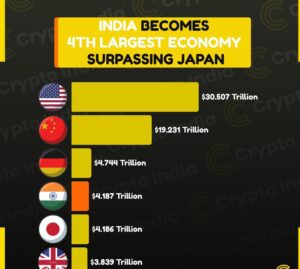IMF Confirms India Overtakes Japan with $4.18 Trillion GDP
India has officially overtaken Japan to become the world’s fourth-largest economy, according to the latest data from the International Monetary Fund (IMF). The announcement was made by NITI Aayog CEO BVR Subrahmanyam following the 10th Governing Council meeting of the policy think tank.

“As of now, we are the fourth-largest economy and have reached the milestone of a USD 4 trillion economy,” Subrahmanyam told reporters, highlighting that the current geopolitical and economic environment is favorable for India’s continued rise.
As per IMF data, India’s GDP now stands at $4.187 trillion, just ahead of Japan’s $4.186 trillion. “India today is bigger than Japan,” Subrahmanyam emphasized.
India Overtakes Japan Top 5 Largest Economies (Nominal GDP)
-
United States – $30.51 trillion
-
China – $19.23 trillion
-
Germany – $4.74 trillion
-
India – $4.187 trillion
-
United Kingdom – $3.38 trillion
Despite its progress, India’s GDP is still roughly one-seventh the size of the United States economy.

IMF Lowers India’s 2025 Growth Projection
According to the April 2025 edition of the IMF’s World Economic Outlook (WEO), India’s economy is projected to grow by 6.2% in 2025 and 6.3% in 2026, continuing to outperform most global and regional peers. However, this represents a downward revision from earlier projections due to rising global trade tensions and increasing uncertainty.
India Ranks 144th in GDP Per Capita
While India has made significant gains in total GDP, its per capita income remains low, ranked 144th globally. According to the IMF, India’s per capita GDP is estimated at $2,850–$2,900, much lower than that of several smaller economies.
The top three countries by per capita GDP are:
-
Luxembourg – $141,080
-
Switzerland – $111,716
-
Ireland – $107,243
Long-Term Growth Trends: India vs China
The IMF notes that in the long term (2025–2050), China is expected to experience a sharp decline in growth, with its GDP growth rate projected to fall by 2.7 percentage points compared to the 2016–2018 average. This is attributed to worsening demographics and the slowing of productivity convergence with developed economies.
India, on the other hand, is expected to see a smaller decline in growth—around 0.7 percentage points—thanks to more favorable demographics in the near term. However, the report warns that from 2050 to 2100, India too will face growth challenges as it reaches its demographic turning point.
Low-income countries, in general, are projected to experience more severe growth slowdowns in the latter half of the century as current demographic dividends shift to demographic pressures.









